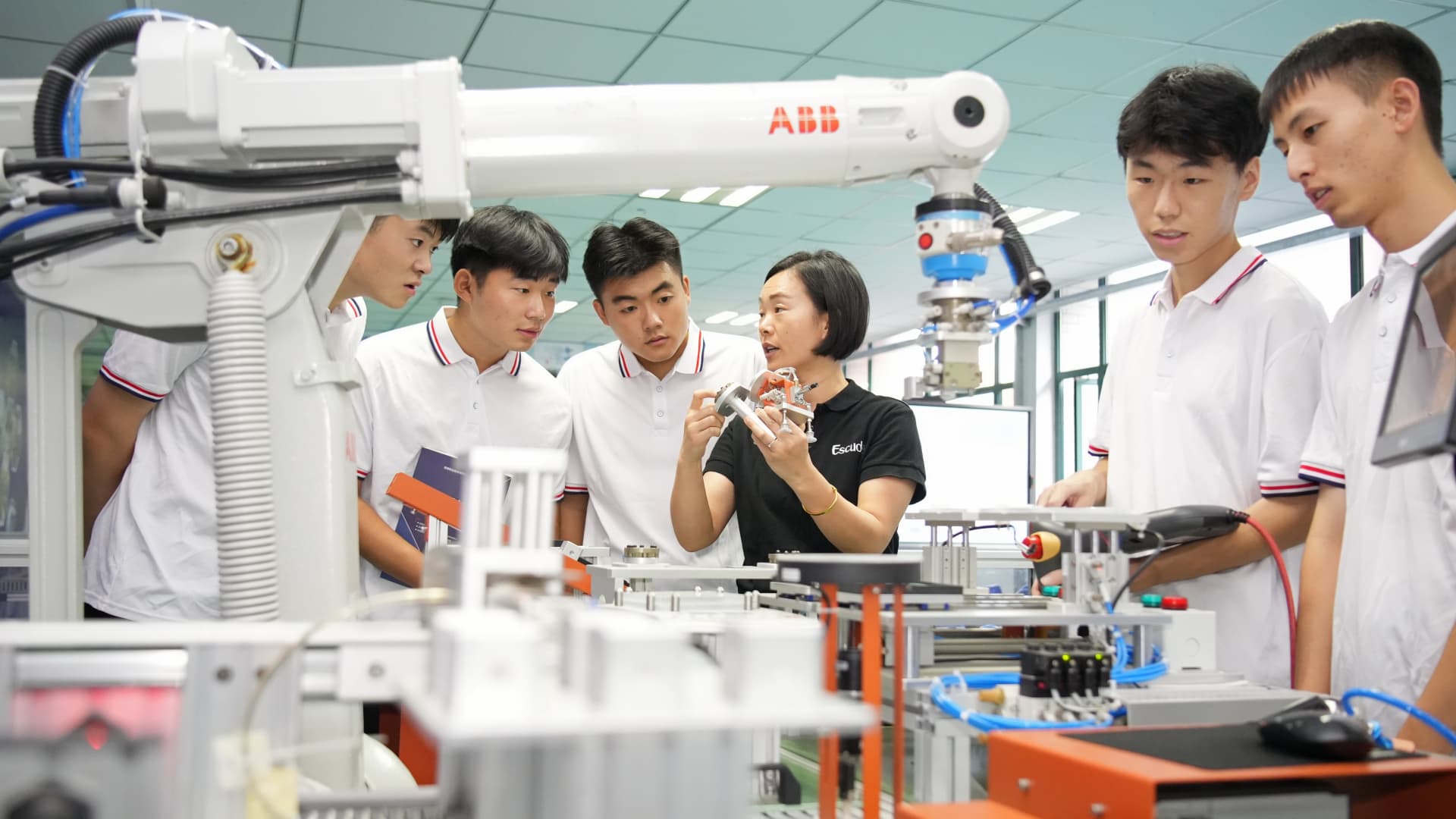
YANTAI, CHINA – SEPTEMBER 8, 2023 – Students conduct an industrial robot training at Yantai Cultural and Tourism Vocational College in Yantai, East China’s Shandong province, Sept 8, 2023. At present, China has built the largest vocational education system in the world, and the middle and higher vocational schools train about 10 million high-quality technical talents every year. (Photo by Costfoto/NurPhoto via Getty Images)
Nurphoto | Nurphoto | Getty Images
BEIJING — China’s vocational school push is producing workers the country’s electric car and semiconductor industries want to hire.
Despite tech company layoffs and record-high youth unemployment in recent years, public filings analyzed by CNBC show marked headcount growth at key industry giants – who largely depend on technical, advanced manufacturing labor.
Electric battery heavyweight CATL‘s staff more than tripled within three years to 118,914 in 2022 – with nearly 80% holding less than a bachelor’s degree.
Chinese semiconductor company SMIC‘s research and development team grew by nearly 30% since 2021 to 2,283 as of June. While doctorate and master’s degree holders contributed the most to the increase, the number of staff with a junior college or lower background rose by 10% — in contrast to an 8% drop for those with bachelor’s degrees.
China’s efforts to build up its own technological capabilities have intensified since the U.S. started to restrict Chinese companies’ access to critical tech such as advanced semiconductors.
The Chinese government has also long tried to develop its vocational education system and learn from similar programs in countries such as Germany.

Beijing made two important changes in 2019 to spur vocational education – a nationally recognized skills certification framework and a call for 300 business entities to provide or sponsor training, pointed out Anyi Wang, associate research scholar at Columbia University and co-author of a 2020 paper on vocational education in China.
“Right now, I think the government is trying to put vocational education in a more important place in the whole education system,” he said, noting other policy changes that indicate Beijing’s recognition that high-tech workers need longer training times.
More complex machines and software systems also mean factory workers aren’t just filling labor-intensive roles anymore, but may be overseeing automated production.
Skills mismatch
While the industry changes, slower economic growth and crackdowns on real estate and internet platform companies have revealed a stark mismatch between graduates’ skills and available jobs.
The unemployment rate for young people ages 16 to 24 climbed to records above 20% this summer before authorities suspended the data release.
“The supply of [what we call] workers with generalized skills to the market is more than the economy can actually [absorb], so you can find a lot of the graduates, they graduate directly into unemployment,” Wang said.
The number of bachelor’s degree graduates rose by 10% in 2022 to 4.7 million, while higher-level vocational schools saw a 24% surge in graduates to 4.9 million, according to the Ministry of Education.
There’s no official jobless rate breakdown by educational background.
But what’s clear is vocational positions require specific skills, Wang said. “So they are having a shortage of workers or applicants.”
Surging demand for auto workers
The latest available official tally of nationwide labor shortages for 2022 found that sales people were in greatest demand, followed by automobile manufacturing workers in second place, up from 19th place previously.
Semiconductor-related manufacturing jobs also made the top 100 positions with the greatest need for workers, the report said.
The number of students focusing on the auto sector has increased significantly over the last several years to about two-thirds of the current enrollment at Nanjing Vocational University of Industry Technology’s transportation school, its dean Wang Wenkai said in a phone interview.
“The market has increased demand for this,” he said in Mandarin, translated by CNBC.
Corporate partnership
In a well-managed vocational education program, a significant benefit for students comes from corporate partners who provide hands-on experience, if not a job after graduation.
Schools CNBC spoke with had existing programs with companies such as CATL, Baidu’s autonomous driving unit and Chinese electric car giant BYD.
Public announcements in the last year also show at least 10 different vocational education schools are in talks for or have launched training institutes with BYD.
Among them, a “BYD Field Engineer College” was launched on Sept. 10 in collaboration with vocational schools in Henan province, whose capital city of Zhengzhou is home to a new BYD factory.
Based on its 2023 strategic plan, BYD will need a large number of field engineers in manufacturing and after-sales service, Liu Junpeng, director of school-enterprise cooperation at BYD’s human resources department, said at the college’s launch event, according to a release by Henan Mechanical and Electrical Vocational College.
BYD did not immediately respond to a CNBC request for comment.
The company does not disclose its workers’ educational background. But public filings reveal its workforce more than tripled over the last six years to 631,500 as of June.
Corporate partnerships also help schools make sure their curriculum is current.
Every summer, teachers at Shaanxi Polytechnic Institute go to work at BYD in the city of Xi’an, according to Xu Jiyang, dean of the institute’s automotive school.

At Shenzhen Polytechnic University, BYD engineers help construct the courses, parts of which also take students to learn on-site at the company, said Zhu Xiaochun, deputy dean of the school of automobiles and transportation.
He claimed junior college students had an employment rate of well over 90%. “In addition to our better students in the bachelor program, [BYD] also needs a large number of workers,” Zhu said in Mandarin, via a CNBC translation. “It’s too easy for our students to find jobs.”
However, one of the biggest challenges for vocational education remains public perception.
“We live in an era of high aspiration. Parents want that for their children,” said Stephen Billett, professor of adult and vocational education at the School of Education and Professional Studies at Griffith University in Australia.
“But often vocational education is being seen as something as far less desirable than those developed through higher education,” he said. “That then leads to this issue of how that can be changed and also how we can have effective vocational education systems.”
